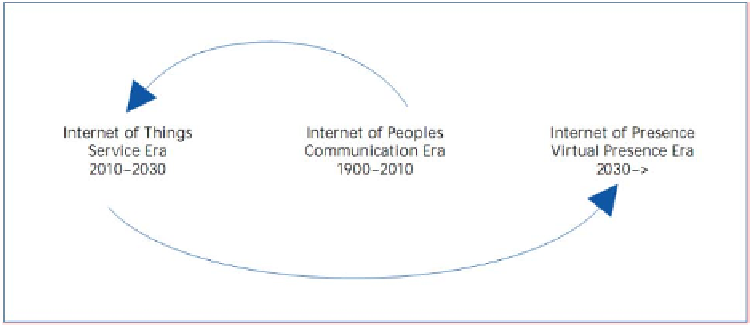Information Technology Reference
In-Depth Information
5.5.1.
Evolution of communication capabilities
The following diagram, proposed by Nokia, predicts the way communication
capabilities are used over twenty years:
the current
Internet of Peoples,
i.e. Communication era connects people via
recognized artefacts;
•
the future
Internet of Things,
i.e. Service era connects artefacts to serve people,
without involving them directly;
•
the distant future
Internet of Presence
,
i.e. virtual presence era connects people
again so that the artefacts are transparent.
•
Figure 9.
The future of communication.
The “
Internet of People
” is the current use of the Internet which started with the
introduction of e-mail, ftp and web-browsers like Mosaic in the early nineties of the
previous century. Originally just to browse and search for all kind of information and
later extended with all kind of services allowing people to create and manage their own
content and know as Web 2.0 (blogs, Twitter, Facebook, Linkedin, Youtube, Photo
websites, etc.). This allows people to actively participate. In last couple of years also
applications based on data bases have been introduced which allow people to maintain
e.g. their health data in personal health records (WebMD and others) and to upload data
from sensors (Microsoft Healthvault and Google Health). Nowadays these systems also
function as a kind of platform for third party services amongst them there are also
service that are able to exchange data with hospital systems.
The vision of the “
Internet of Things
” (Internet of Things in 2020 (2008)) era can
be described as “Interconnected objects having an active role in Internet networks”. It
is foreseeable that any object will have a unique way of identification in the coming
future, creating an addressable continuum of computers, sensors, actuators, mobile
phones; i.e. any thing or object around us. Having the capacity of addressing each other
and verifying their identities, all these objects will be able to exchange information and,
if necessary, actively process information according to predefined schemes, which may
or may not be deterministic.
With respect to AAL, the integration of communication capabilities between
objects with RFID tags, sensors and actuators into hybrid wireless sensor networks is
of utmost importance and these networks are characterized by modularity, reliability,

